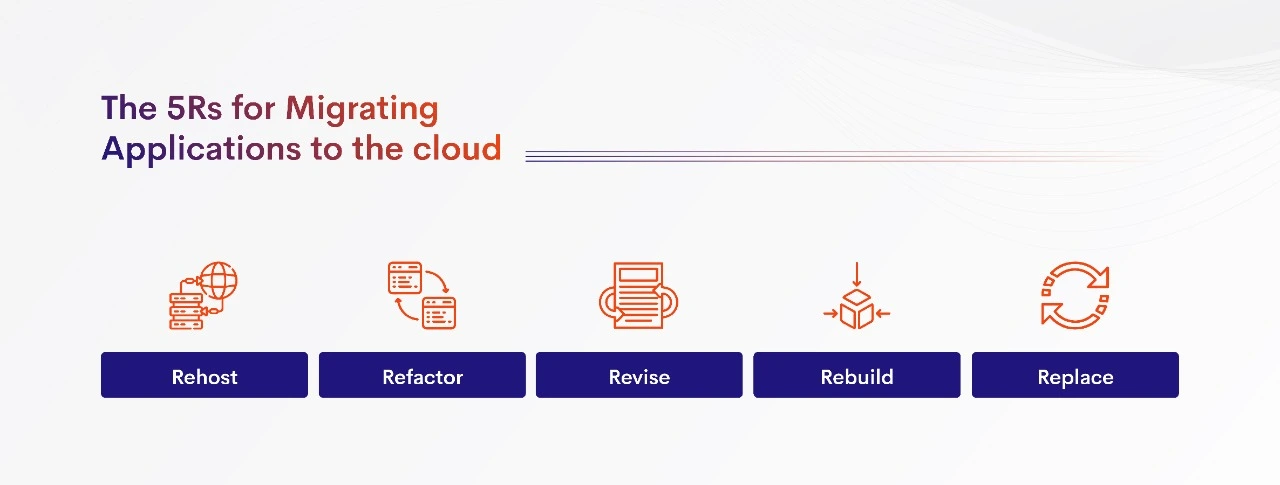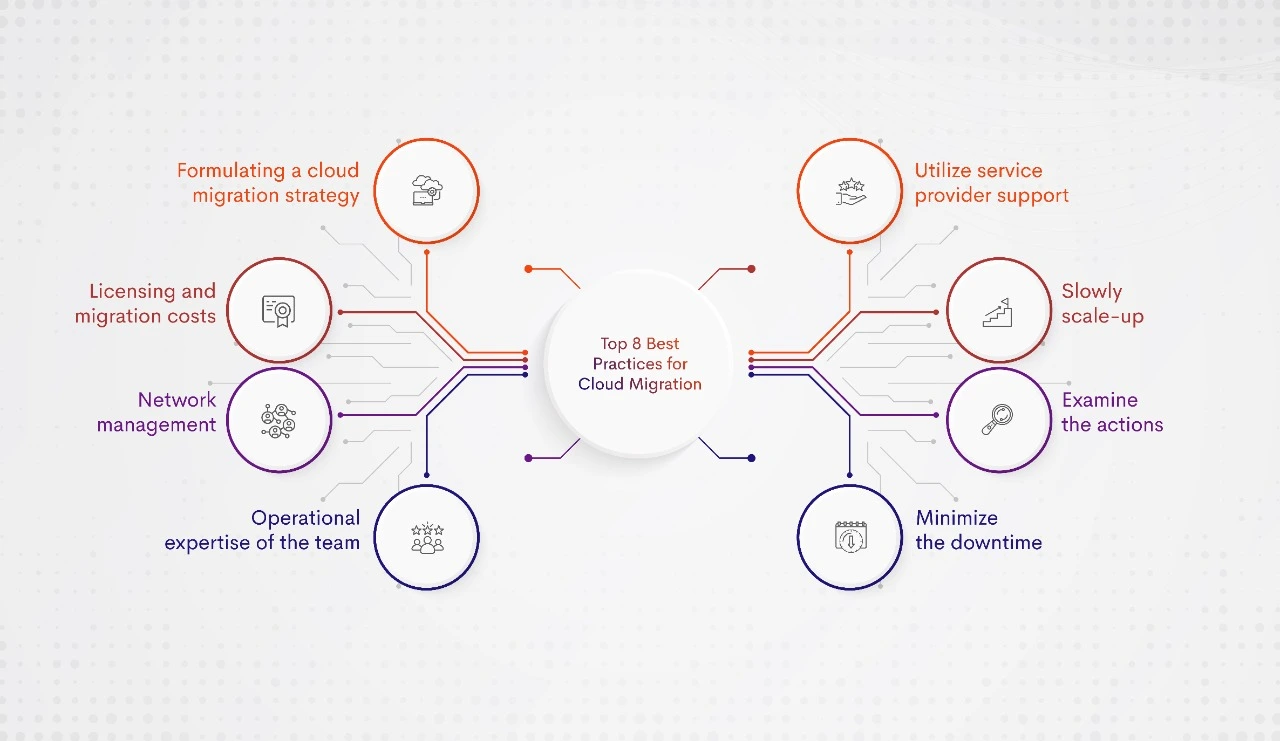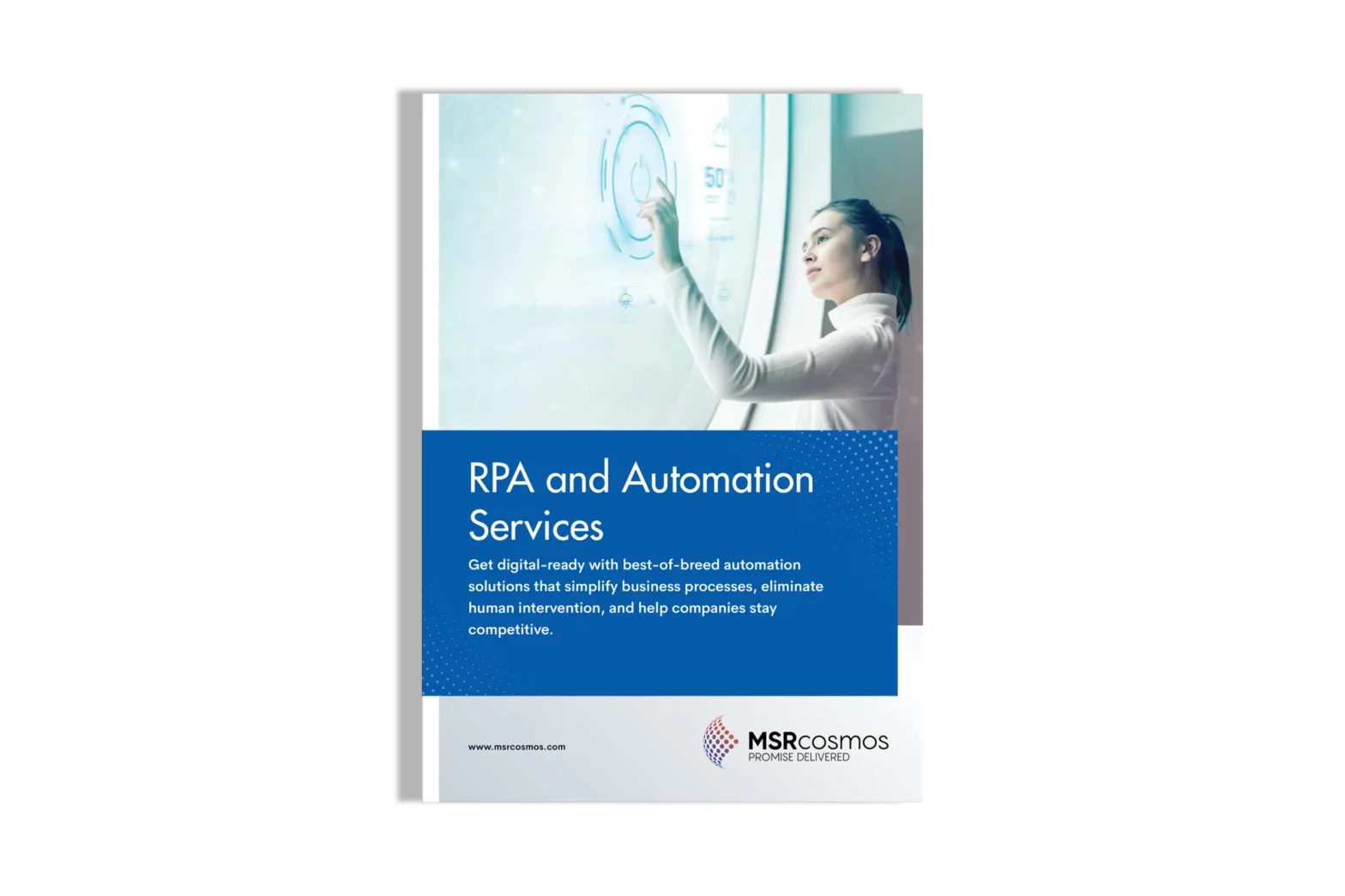- Blog
- June 10, 2022
Top 8 best practices for cloud migration

- Blog
- June 10, 2022
Top 8 best practices for cloud migration
The rise of hyper-scale public Cloud infrastructure has resulted in new and enhanced ways of improving IT infrastructure provisioning as IaaS repeatability. Application size, high levels of customization, and a lack of skills frequently frustrate cloud transformation plans for enterprise applications. Many factors will influence the optimal outcome, including your organization’s devotion, your team’s competence, technological requirements, and many more. This is where companies need best practices to plan their cloud migration initiatives. In this blog, we have articulated some of the top-notch cloud migration best practices. Let us get started.
Top 8 cloud migration best practices
1. Formulating a Cloud migration strategy: Organizations must have a clear plan and strategy for migrating each application. An effective approach will leverage the benefits of Cloud infrastructure while minimizing the time, effort, cost, and danger of migration. According to Gartner, the 5Rs for migrating applications to the Cloud are: rehost, refactor, revise, rebuild, or replace.

- Rehost: A process of migrating your application from on-premises to Cloud settings without modifying them is referred to as rehosting. This method is simple and saves money on infrastructure and operations.
- Refactor: Refactoring is the method of converting a non-Cloud app into Cloud-native software. Organizations wishing to move from a traditional to a service-oriented (or server-less) architecture in the Cloud can utilize this method to increase flexibility, enhance business longevity, and reduce operational costs.
- Revise: Revise entails relocating apps in their current state with only minor versioning changes. Before shifting to the Cloud, this method makes a few optimizations as transitioning from self-hosted infrastructure to managed services and switching from commercial software to open source.
- Rebuild: Rebuilding the solution on PaaS, removing current code, and completely re-architecting the application is another key Cloud application migration technique. It necessitates the adoption of new code and frameworks thus allowing customers to access cutting-edge technologies on the Cloud service provider’s platform.
- Replace: This category includes replacing a current application with commercial software that is delivered as a service. When business requirements change, it works well since the cost of moving a development team is avoided.
2. Licensing and migration costs: When it comes to setting a Cloud migration strategy, a preliminary estimate is generally the initial step. Admins must estimate the cost of existing hardware and software assets before comparing it to the cost of a Cloud-based system. Choosing whether to use BYOL (bring your own license) or a pay-per-use license from the Cloud provider or marketplace is the next set of crucial considerations in the migration process. By leveraging current licenses, BYOL reduces the cost and risk associated while migrating to a Cloud platform. Pay-as-you-Go Cloud licensing is a payment system that only charges you depending on your organization’s usage and prevents resource waste.
Begin your Cloud transition journey with us
3. Network management: Some companies, particularly large firms, may be concerned that the internet is too slow and insecure to meet their goals. Some public Cloud providers recognize that utilizing the internet isn’t always the best solution. From business offices, a dedicated network connection is established to the Cloud service provider’s infrastructure. It has a feature that allows you to connect your network directly to the Cloud without utilizing the internet.
4. Operational expertise of the team: Human errors account for the majority of data losses in SaaS. Set up access levels for your team so that only the right people have access to the data they need. Employee training should be carried out to educate the employee to use Cloud-based applications. It will cut down on security breaches and pilot errors.
5. Utilize service provider support: During any Cloud migration, a good support team can be a valuable ally. Cloud support personnel are experts in the service for which they work, and they should be able to quickly answer technical inquiries or assist you with any problems you may be experiencing.
6. Slowly scale-up: Businesses should start with a modest application, plan a migration strategy, and adapt. It aids in the identification of gaps and the refinement of their master migration plan. This activity will also assist technical staff in becoming more comfortable with Cloud services as well as help stakeholders realize the benefits of Cloud migration.
7. Examine the actions: Create a test environment to see how well your backup strategy works in the event of a disaster. Repeat this process as needed to adapt the backup strategy. After you’ve finished with backups, use automated migration methods wherever necessary.
8. Minimize the downtime: This is considered as one of the more critical steps in the cloud migration journey. Moving your data is one of the most difficult components of cloud migration. You risk having to access your data over a distance between on-premise and cloud data centres if users don’t migrate the data at the same time as the services that use it. It will almost certainly result in latency and performance difficulties. Furthermore, maintaining network security, synchronisation, and self-consistency during data transfer needs tight correlation entirely with minimum application downtime. You must move your data and the programs that consume it at the same time to achieve linear system application performance. Companies usually rely on the expertise of a migration architect, a role that may significantly improve the efficiency of any cloud move and minimizes the downtime.
It’s time to start the Cloud migration now you’ve completed all of your preparations. All data and users will be ready to move to the Cloud infrastructure.
Start your cloud migration with MSRcosmos
At MSRcosmos, we understand the art of cloud migrations. Our success track record holds more than 125+ cloud migrations and we have great partnerships with cloud giants such as Microsoft, AWS, GCP etc. You can connect with our experts.
We are ready to assist you with a complete and in-depth walkthrough on how to move to the Cloud and overcome the challenges of the Cloud migration.

Begin your Cloud transition journey with us.
Endnote
The road to Cloud migration is not easy. If not accurately planned, migration of corporate legacy applications or rehosting infrastructure from the data center to the Cloud can quickly become a black hole. Even if the Cloud transfer is successful, the system must be maintained on a regular basis in order to run properly. It’s critical to keep refining the infrastructure and adopting Cloud design principles to get the most out of the Cloud transformation.




